Herpes simplex virus 1 pUL34 plays a critical role in cell-to-cell spread of virus in addition to its role in virus replication
- PMID: 21561917
- PMCID: PMC3126596
- DOI: 10.1128/JVI.00262-11
Herpes simplex virus 1 pUL34 plays a critical role in cell-to-cell spread of virus in addition to its role in virus replication
Abstract
Herpes simplex virus (HSV) pUL34 plays a critical role in virus replication by mediating egress of nucleocapsids from the infected cell nucleus. We have identified a mutation in pUL34 (Y68A) that produces a major defect in virus replication and impaired nuclear egress but also profoundly inhibits cell-to-cell spread and trafficking of gE. Virion release to the extracellular medium is not affected by the Y68A mutation, indicating that the mutation specifically inhibits cell-to-cell spread. We isolated extragenic suppressors of the Y68A plaque formation defect and mapped them by a combination of high-throughput Illumina sequencing and PCR-based screening. We found that suppression is highly correlated with a nonsense mutation in the US9 gene, which plays a critical role in cell-to-cell spread of HSV-1 in neurons. The US9 mutation alone is not sufficient to suppress the Y68A spread phenotype, indicating a likely role for multiple viral factors.
Figures
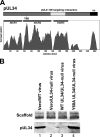
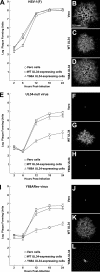
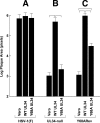
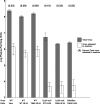


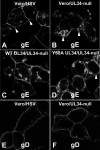
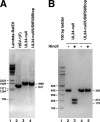

Similar articles
-
Extragenic Suppression of a Mutation in Herpes Simplex Virus 1 UL34 That Affects Lamina Disruption and Nuclear Egress.J Virol. 2016 Nov 14;90(23):10738-10751. doi: 10.1128/JVI.01544-16. Print 2016 Dec 1. J Virol. 2016. PMID: 27654296 Free PMC article.
-
Roles of the Interhexamer Contact Site for Hexagonal Lattice Formation of the Herpes Simplex Virus 1 Nuclear Egress Complex in Viral Primary Envelopment and Replication.J Virol. 2019 Jun 28;93(14):e00498-19. doi: 10.1128/JVI.00498-19. Print 2019 Jul 15. J Virol. 2019. PMID: 31043535 Free PMC article.
-
Cell Culture Evolution of a Herpes Simplex Virus 1 (HSV-1)/Varicella-Zoster Virus (VZV) UL34/ORF24 Chimeric Virus Reveals Novel Functions for HSV Genes in Capsid Nuclear Egress.J Virol. 2021 Nov 9;95(23):e0095721. doi: 10.1128/JVI.00957-21. Epub 2021 Sep 15. J Virol. 2021. PMID: 34523964 Free PMC article.
-
Analysis of a charge cluster mutation of herpes simplex virus type 1 UL34 and its extragenic suppressor suggests a novel interaction between pUL34 and pUL31 that is necessary for membrane curvature around capsids.J Virol. 2010 Apr;84(8):3921-34. doi: 10.1128/JVI.01638-09. Epub 2010 Jan 27. J Virol. 2010. PMID: 20106917 Free PMC article.
-
Roles of the Phosphorylation of Herpes Simplex Virus 1 UL51 at a Specific Site in Viral Replication and Pathogenicity.J Virol. 2018 Aug 29;92(18):e01035-18. doi: 10.1128/JVI.01035-18. Print 2018 Sep 15. J Virol. 2018. PMID: 29976672 Free PMC article.
Cited by
-
HSV-1 Cytoplasmic Envelopment and Egress.Int J Mol Sci. 2020 Aug 19;21(17):5969. doi: 10.3390/ijms21175969. Int J Mol Sci. 2020. PMID: 32825127 Free PMC article. Review.
-
Extragenic Suppression of a Mutation in Herpes Simplex Virus 1 UL34 That Affects Lamina Disruption and Nuclear Egress.J Virol. 2016 Nov 14;90(23):10738-10751. doi: 10.1128/JVI.01544-16. Print 2016 Dec 1. J Virol. 2016. PMID: 27654296 Free PMC article.
-
Widely Used Herpes Simplex Virus 1 ICP0 Deletion Mutant Strain dl1403 and Its Derivative Viruses Do Not Express Glycoprotein C Due to a Secondary Mutation in the gC Gene.PLoS One. 2015 Jul 17;10(7):e0131129. doi: 10.1371/journal.pone.0131129. eCollection 2015. PLoS One. 2015. PMID: 26186447 Free PMC article.
-
Host Vesicle Fusion Protein VAPB Contributes to the Nuclear Egress Stage of Herpes Simplex Virus Type-1 (HSV-1) Replication.Cells. 2019 Feb 3;8(2):120. doi: 10.3390/cells8020120. Cells. 2019. PMID: 30717447 Free PMC article.
-
Functions of the UL51 protein during the herpesvirus life cycle.Front Microbiol. 2024 Aug 26;15:1457582. doi: 10.3389/fmicb.2024.1457582. eCollection 2024. Front Microbiol. 2024. PMID: 39252835 Free PMC article. Review.
References
-
- Balan P., et al. 1994. An analysis of the in vitro and in vivo phenotypes of mutants of herpes simplex virus type 1 lacking glycoproteins gG, gE, gI or the putative gJ. J. Gen. Virol. 75:1245–1258 - PubMed
Publication types
MeSH terms
Substances
Grants and funding
LinkOut - more resources
Full Text Sources
Other Literature Sources

